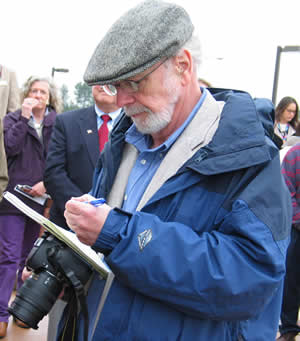By Chris Joyce

Craig Wilkins is seen here in May 2005 during the opening of the Hwy 371 Welcome Center south of Baxter. Photo by Jenny Seelen |
A voice well-known during the past three decades for chronicling Mn/DOT’s moments, both great and small, fell silent last week.
Craig Wilkins, communications specialist in the Office of Communications, died Jan. 27, two days after suffering a heart attack at his home in Minneapolis. He was 66.
“Craig was a talented writer and storyteller, but it was ‘Craig the Man’ I really appreciated,” said Kevin Gutknecht, Office of Communications director. “He was engaging, had a great sense humor, and was a devoted family guy. He seemed to have a pretty good balance in his life.”
Craig wore many hats at Mn/DOT over the years: editor, assistant editor, staff writer and photographer. Regardless of the title preceding his name, many folks in the department considered him to be the go-to guy for employee and media communications.
From his arrival in January 1980 onward, Craig covered just about every topic related to transportation that was possible—crews transplanting trees or filling potholes, demolishing a bridge or constructing its replacement, opening a new rest area or closing a road. And countless others.
He loved planes, trains and all things modal. For both the 25th anniversary celebration of Mn/DOT in 2001 and the 50th anniversary of the interstate in 2006, he spent weeks interviewing current and retired employees and digging through Minnesota Historical Society archives. The end products were two series of well-researched and informative articles detailing the state’s transportation history.
But his particular passion was writing about the people of Mn/DOT.
He made it a point to visit other offices and the districts to speak with employees about their jobs, their families…and their favorite restaurants. He could tell you the best bakeries anywhere near a state highway, and always had a story or two to share about someone he had met on the road.
His training in journalism and years as a reporter for the St. Cloud Daily Times prior to joining Mn/DOT honed Craig’s ability to produce a lot of copy quickly, easily cutting to the heart of a story. His folksy style made even the most technical story readable.
“On a typewriter, on a computer, on the back of an envelope, what will forever remain a strong memory for me was Craig’s ability to write. Not just to write, but to write stories that drew me in and kept me reading,” said Lucy Kender, human resources project manager, Office of Human Resources, and former Communications director.
Some of Craig’s most enjoyable writing was never intended for publication, such as the witty e-mails and little transportation ditties that he would compose to amuse himself as much as others. One of his last such riffs was a public service announcement—written as a rap song—to promote winter driving safety.
Craig’s passing leaves a huge hole in our hearts, and to a certain extent, in Newsline. No other employee wrote about Mn/DOT so prolifically, artfully and affectionately, over so long a period, as Craig did. We are richer as an agency for the hundreds of stories that he chronicled during the past 29 years, and for the countless memories he created for us in the process.
In 2001, he captured his experience-to-date:
“Paging through old copies of Mn/DOT publications can feel like looking at your high school year book, a wedding album or a box of vacation slides. A casual glance draws you in and starts enveloping you in memories and a kaleidoscope of associations. Soon you may forget just exactly what it was you were looking for. Often, after a while, it doesn’t matter…
“It’s been my pleasure—and occasional pain—to edit, write for and agonize over the DOT Scene, the Express and the Mn/DOT NEWS (Newsline’s predecessors) during the past 20 years.”
The pleasure was all ours, Craig.
Memorial service for Craig Wilkins set for Feb. 7 in Minneapolis
A memorial service for Craig Wilkins will be held Saturday, Feb. 7, at 5:30 p.m., at the First Universalist Church, 3400 Dupont Ave. So., Minneapolis. Visitation will begin at 4 p.m.
Wilkins joined Mn/DOT in January 1980 after spending nine years as a reporter covering municipal and county affairs for the St. Cloud Daily Times.
A New Jersey native, he enlisted in the Air Force at the age of 17 and served four years as an Airman First Class. He received a degree in journalism from St. Cloud State University in 1971.
Wilkins’ survivors include his spouse, Candace Barrick, and son Ethan Wilkins, and many friends and colleagues.
|
|



